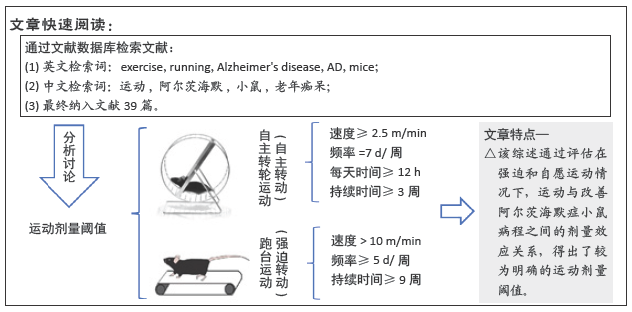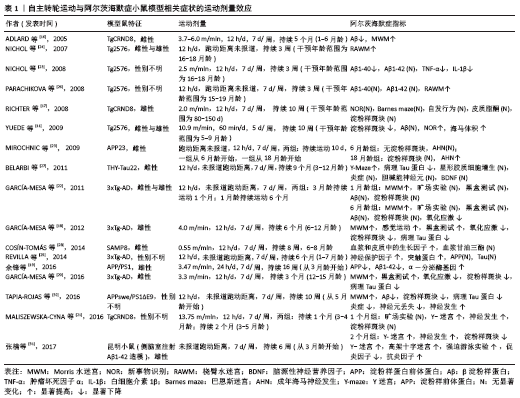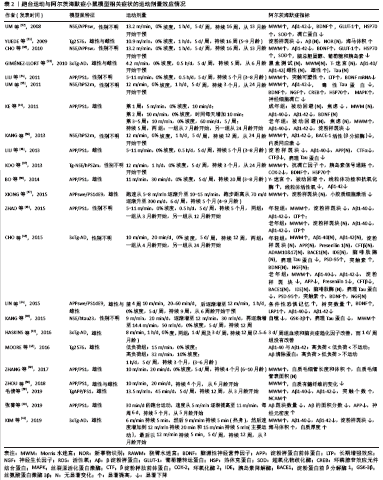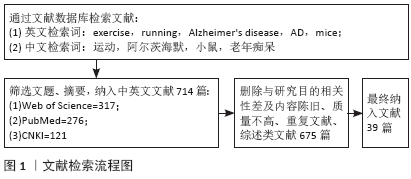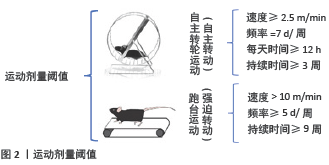[1] MARTIN P, ANDERS W. World Alzheimer Report 2016. Alzheimer’s Disease International,2016.
[2] BROOKMEYER R, JOHNSON E, ZIEGLER-GRAHAM K, et al. Forecasting the global burden of Alzheimer’s disease. Alzheimers Dement. 2007;3(3):186-191.
[3] PRINCE M, BRYCE R, ALBANESE E, et al. The global prevalence of dementia: a systematic review and metaanalysis. Alzheimers Dement. 2013;9(1):63-75.e2.
[4] KENNEDY G, HARDMAN RJ, MACPHERSON H, et al. How Does Exercise Reduce the Rate of Age-Associated Cognitive Decline? A Review of Potential Mechanisms. J Alzheimers Dis. 2017;55(1):1-18.
[5] LIANG KY, MINTUN MA, FAGAN AM, et al. Exercise and Alzheimer’s disease biomarkers in cognitively normal older adults. Ann Neurol. 2010;68(3):311-318.
[6] WOLF SA, KRONENBERG G, LEHMANN K, et al. Cognitive and physical activity differently modulate disease progression in the amyloid precursor protein (APP)-23 model of Alzheimer’s disease. Biol Psychiatry. 2006;60(12):1314-1323.
[7] 朱为模.运动处方的过去、现在与未来[J].体育科研,2020,41(1):1-18.
[8] EIJSVOGELS TM, MOLOSSI S, LEE DC, et al. Exercise at the Extremes: The Amount of Exercise to Reduce Cardiovascular Events. J Am Coll Cardiol. 2016;67(3):316-329.
[9] SVENSSON M, ROSVALL P, BOZA-SERRANO A, et al. Forced treadmill exercise can induce stress and increase neuronal damage in a mouse model of global cerebral ischemia. Neurobiol Stress. 2016;5:8-18.
[10] BAGLIETTO-VARGAS D, CHEN Y, SUH D, et al. Short-term modern life-like stress exacerbates Aβ-pathology and synapse loss in 3xTg-AD mice. J Neurochem. 2015;134(5):915-926.
[11] YUEDE CM, ZIMMERMAN SD, DONG H, et al. Effects of voluntary and forced exercise on plaque deposition, hippocampal volume, and behavior in the Tg2576 mouse model of Alzheimer’s disease. Neurobiol Dis. 2009;35(3):426-432.
[12] CRACCHIOLO JR, MORI T, NAZIAN SJ, et al. Enhanced cognitive activity--over and above social or physical activity--is required to protect Alzheimer’s mice against cognitive impairment, reduce Abeta deposition, and increase synaptic immunoreactivity. Neurobiol Learn Mem. 2007;88(3):277-294.
[13] GIMÉNEZ-LLORT L, GARCÍA Y, BUCCIERI K, et al. Gender-Specific Neuroimmunoendocrine Response to Treadmill Exercise in 3xTg-AD Mice. Int J Alzheimers Dis. 2010;2010:128354.
[14] LIN TW, SHIH YH, CHEN SJ, et al. Running exercise delays neurodegeneration in amygdala and hippocampus of Alzheimer’s disease (APP/PS1) transgenic mice. Neurobiol Learn Mem. 2015;118:189-197.
[15] MOORE KM, GIRENS RE, LARSON SK, et al. A spectrum of exercise training reduces soluble Aβ in a dose-dependent manner in a mouse model of Alzheimer’s disease. Neurobiol Dis. 2016;85:218-224.
[16] ADLARD PA, PERREAU VM, POP V, et al. Voluntary exercise decreases amyloid load in a transgenic model of Alzheimer’s disease. J Neurosci. 2005;25(17):4217-4221.
[17] RICHTER H, AMBRÉE O, LEWEJOHANN L, et al. Wheel-running in a transgenic mouse model of Alzheimer’s disease: protection or symptom? Behav Brain Res. 2008;190(1):74-84.
[18] GARCÍA-MESA Y, GIMÉNEZ-LLORT L, LÓPEZ LC, et al. Melatonin plus physical exercise are highly neuroprotective in the 3xTg-AD mouse. Neurobiol Aging. 2012;33(6):1124.e13-29.
[19] 余锋,徐波,季浏.α-分泌酶在自主运动调节APP/PS1转基因小鼠海马APP与Aβ42中的作用研究[J].体育科学,2016,36(7):49-55.
[20] GARCÍA-MESA Y, COLIE S, CORPAS R, et al. Oxidative Stress Is a Central Target for Physical Exercise Neuroprotection Against Pathological Brain Aging. J Gerontol A Biol Sci Med Sci. 2016;71(1):40-49.
[21] MALISZEWSKA-CYNA E, XHIMA K, AUBERT I. A Comparative Study Evaluating the Impact of Physical Exercise on Disease Progression in a Mouse Model of Alzheimer’s Disease. J Alzheimers Dis. 2016;53(1):243-257.
[22] GARCÍA-MESA Y, LÓPEZ-RAMOS JC, GIMÉNEZ-LLORT L, et al. Physical exercise protects against Alzheimer’s disease in 3xTg-AD mice. J Alzheimers Dis. 2011; 24(3):421-454.
[23] MIROCHNIC S, WOLF S, STAUFENBIEL M, et al. Age effects on the regulation of adult hippocampal neurogenesis by physical activity and environmental enrichment in the APP23 mouse model of Alzheimer disease. Hippocampus. 2009;19(10):1008-1018.
[24] NICHOL KE, PARACHIKOVA AI, COTMAN CW. Three weeks of running wheel exposure improves cognitive performance in the aged Tg2576 mouse. Behav Brain Res. 2007;184(2):124-132.
[25] NICHOL KE, POON WW, PARACHIKOVA AI, et al. Exercise alters the immune profile in Tg2576 Alzheimer mice toward a response coincident with improved cognitive performance and decreased amyloid. J Neuroinflammation. 2008;5:13.
[26] PARACHIKOVA A, NICHOL KE, COTMAN CW. Short-term exercise in aged Tg2576 mice alters neuroinflammation and improves cognition. Neurobiol Dis. 2008;30(1):121-129.
[27] BELARBI K, BURNOUF S, FERNANDEZ-GOMEZ FJ, et al. Beneficial effects of exercise in a transgenic mouse model of Alzheimer’s disease-like Tau pathology. Neurobiol Dis. 2011;43(2):486-494.
[28] COSÍN-TOMÁS M, ALVAREZ-LÓPEZ MJ, SANCHEZ-ROIGE S, et al. Epigenetic alterations in hippocampus of SAMP8 senescent mice and modulation by voluntary physical exercise. Front Aging Neurosci. 2014;6:51.
[29] REVILLA S, SUÑOL C, GARCÍA-MESA Y, et al. Physical exercise improves synaptic dysfunction and recovers the loss of survival factors in 3xTg-AD mouse brain. Neuropharmacology. 2014;81:55-63.
[30] TAPIA-ROJAS C, ARANGUIZ F, VARELA-NALLAR L, et al. Voluntary Running Attenuates Memory Loss, Decreases Neuropathological Changes and Induces Neurogenesis in a Mouse Model of Alzheimer’s Disease. Brain Pathol. 2016; 26(1):62-74.
[31] 张楠,王莉智,杨桂姣,等.自主跑轮运动对阿尔兹海默病模型小鼠认知、情绪以及杏仁核炎性因子表达的影响[J].神经解剖学杂志,2017,33(6):741-747.
[32] UM HS, KANG EB, LEEM YH, et al. Exercise training acts as a therapeutic strategy for reduction of the pathogenic phenotypes for Alzheimer’s disease in an NSE/APPsw-transgenic model. Int J Mol Med. 2008;22(4):529-539.
[33] CHO JY, UM HS, KANG EB, et al. The combination of exercise training and alpha-lipoic acid treatment has therapeutic effects on the pathogenic phenotypes of Alzheimer’s disease in NSE/APPsw-transgenic mice. Int J Mol Med. 2010;25(3): 337-346.
[34] LIU HL, ZHAO G, CAI K, et al. Treadmill exercise prevents decline in spatial learning and memory in APP/PS1 transgenic mice through improvement of hippocampal long-term potentiation. Behav Brain Res. 2011;218(2):308-314.
[35] UM HS, KANG EB, KOO JH, et al. Treadmill exercise represses neuronal cell death in an aged transgenic mouse model of Alzheimer’s disease. Neurosci Res. 2011;69(2):161-173.
[36] KANG EB, KWON IS, KOO JH, et al. Treadmill exercise represses neuronal cell death and inflammation during Aβ-induced ER stress by regulating unfolded protein response in aged presenilin 2 mutant mice. Apoptosis. 2013;18(11):1332-1347.
[37] KOO JH, KWON IS, KANG EB, et al. Neuroprotective effects of treadmill exercise on BDNF and PI3-K/Akt signaling pathway in the cortex of transgenic mice model of Alzheimer’s disease. J Exerc Nutrition Biochem. 2013;17(4):151-160.
[38] BO H, KANG W, JIANG N, et al. Exercise-induced neuroprotection of hippocampus in APP/PS1 transgenic mice via upregulation of mitochondrial 8-oxoguanine DNA glycosylase. Oxid Med Cell Longev. 2014;2014:834502.
[39] 毛倩. 跑台运动对TgAPP/PS1小鼠海马离子型谷氨酸受体介导的突触可塑性的影响研究[D].上海:华东师范大学,2019.
[40] 张菁. 长期运动训练对阿尔茨海默病的神经保护作用和机制研究[M]. 济南:山东大学,2019.
[41] KIM D, CHO J, KANG H. Protective effect of exercise training against the progression of Alzheimer’s disease in 3xTg-AD mice. Behav Brain Res. 2019;374: 112105.
[42] HASKINS M, JONES TE, LU Q, et al. Early alterations in blood and brain RANTES and MCP-1 expression and the effect of exercise frequency in the 3xTg-AD mouse model of Alzheimer’s disease. Neurosci Lett. 2016;610:165-170.
[43] CHO J, SHIN MK, KIM D, et al. Treadmill Running Reverses Cognitive Declines due to Alzheimer Disease. Med Sci Sports Exerc. 2015;47(9):1814-1824.
[44] KE HC, HUANG HJ, LIANG KC, et al. Selective improvement of cognitive function in adult and aged APP/PS1 transgenic mice by continuous non-shock treadmill exercise. Brain Res. 2011;1403:1-11.
[45] ZHAO G, LIU HL, ZHANG H, et al. Treadmill exercise enhances synaptic plasticity, but does not alter β-amyloid deposition in hippocampi of aged APP/PS1 transgenic mice. Neuroscience. 2015;298:357-366.
[46] LIU HL, ZHAO G, ZHANG H, et al. Long-term treadmill exercise inhibits the progression of Alzheimer’s disease-like neuropathology in the hippocampus of APP/PS1 transgenic mice. Behav Brain Res. 2013;256:261-272.
[47] XIONG JY, LI SC, SUN YX, et al. Long-term treadmill exercise improves spatial memory of male APPswe/PS1dE9 mice by regulation of BDNF expression and microglia activation. Biol Sport. 2015;32(4):295-300.
[48] KANG EB, CHO JY. Effect of treadmill exercise on PI3K/AKT/mTOR, autophagy, and Tau hyperphosphorylation in the cerebral cortex of NSE/htau23 transgenic mice. J Exerc Nutrition Biochem. 2015;19(3):199-209.
[49] ZHANG Y, CHAO FL, ZHOU CN, et al. Effects of exercise on capillaries in the white matter of transgenic AD mice. Oncotarget. 2017;8(39):65860-65875.
[50] ZHOU CN, CHAO FL, ZHANG Y, et al. Sex Differences in the White Matter and Myelinated Fibers of APP/PS1 Mice and the Effects of Running Exercise on the Sex Differences of AD Mice. Front Aging Neurosci. 2018;10:243.
|
